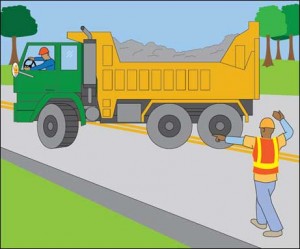 A backover incident occurs when a backing vehicle strikes a worker who is standing, walking, or kneeling behind the vehicle. These incidents can be prevented. According to the Bureau of Labor Statistics, over 70 workers died from backover incidents in 2011. These kinds of incidents can occur in different ways. Click on the link to learn more.
A backover incident occurs when a backing vehicle strikes a worker who is standing, walking, or kneeling behind the vehicle. These incidents can be prevented. According to the Bureau of Labor Statistics, over 70 workers died from backover incidents in 2011. These kinds of incidents can occur in different ways. Click on the link to learn more.
Category: Risk Management
Building the Business Case for Behavioral Safety
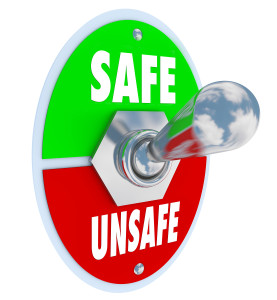 How do you sell a behavioral safety program to management? Keep these few pointers in mind.
How do you sell a behavioral safety program to management? Keep these few pointers in mind.
- Partner with someone in Accounting or Finance to build the financial case for implementing a behavioral safety program. Use the terminology of investment.
- Stress behavioral safety is an investment, not a cost. Show how the commitment of resources can earn the company financial returns or gain future benefits or advantages.
- To help with number two, get current/past cost data on workers’ compensation and follow the ROI guidelines of your organization. Project investment returns by using direct and indirect costs.
- Stress that behavioral safety helps contribute to fewer lost time incidents and workers’ compensation (WC) claims, lower WC premiums and admin costs, higher employee morale, a better reputation and more.
What Is an OSHA DART rate?
 The Occupational Safety and Health Administration (OSHA) measures illness and injury by using an acronym called DART. DART stands for “Days Away, Restricted and Transferred.” Companies use a formula designed by OSHA to calculate their DART. The variables used in this formula come from the company’s OSHA 300 form. The OSHA 300 form is used to track recordable injuries and illnesses within a given company in a given year.
The Occupational Safety and Health Administration (OSHA) measures illness and injury by using an acronym called DART. DART stands for “Days Away, Restricted and Transferred.” Companies use a formula designed by OSHA to calculate their DART. The variables used in this formula come from the company’s OSHA 300 form. The OSHA 300 form is used to track recordable injuries and illnesses within a given company in a given year.
Job Stress and Health
 Stress sets off an alarm in the brain, which responds by preparing the body for defensive action. The nervous system is aroused and hormones are released to sharpen the senses, quicken the pulse, deepen respiration, and tense the muscles. This response (sometimes called the fight or flight response) is important because it helps us defend against threatening situations. The response is preprogrammed biologically. Everyone responds in much the same way, regardless of whether the stressful situation is at work or home.
Stress sets off an alarm in the brain, which responds by preparing the body for defensive action. The nervous system is aroused and hormones are released to sharpen the senses, quicken the pulse, deepen respiration, and tense the muscles. This response (sometimes called the fight or flight response) is important because it helps us defend against threatening situations. The response is preprogrammed biologically. Everyone responds in much the same way, regardless of whether the stressful situation is at work or home.
Short-lived or infrequent episodes of stress pose little risk. But when stressful situations go unresolved, the body is kept in a constant state of activation, which increases the rate of wear and tear to biological systems. Ultimately, fatigue or damage results, and the ability of the body to repair and defend itself can become seriously compromised. As a result, the risk of injury or disease escalates.
In the past 20 years, many studies have looked at the relationship between job stress and a variety of ailments. Mood and sleep disturbances, upset stomach and headache, and disturbed relationships with family and friends are examples of stress-related problems that are quick to develop and are commonly seen in these studies. These early signs of job stress are usually easy to recognize. But the effects of job stress on chronic diseases are more difficult to see because chronic diseases take a long time to develop and can be influenced by many factors other than stress. Nonetheless, evidence is rapidly accumulating to suggest that stress plays an important role in several types of chronic health problems-especially cardiovascular disease, musculoskeletal disorders, and psychological disorders.
Health care expenditures are nearly 50% greater for workers who report high levels of stress.
-Journal of Occupational and Environmental Medicine
via CDC – NIOSH Publications and Products – STRESS…At Work (99-101).
Avoidable Workplace Health and Safety Hazards
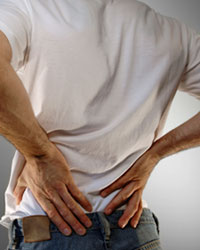 When it comes to non-fatal workplace injuries, the clear leaders are incidents of ergonomic problems and overexertion. They affect people in manufacturing, service, and office settings and regulatory bodies are increasingly cracking down on employers who ignore their employees ergonomic needs. Furthermore, because these injuries can give rise to chronic conditions, they result in one of the higher rates of lost work time.
When it comes to non-fatal workplace injuries, the clear leaders are incidents of ergonomic problems and overexertion. They affect people in manufacturing, service, and office settings and regulatory bodies are increasingly cracking down on employers who ignore their employees ergonomic needs. Furthermore, because these injuries can give rise to chronic conditions, they result in one of the higher rates of lost work time.
via 9 Avoidable Workplace Health and Safety Hazards | Inc.com.
Communication Key to Workplace Safety
 Dangerous working conditions not only pose threats to the safety and livelihood of workers, but also have major ramifications that can affect families, employers and communities. Research indicates the importance of the availability of safety information and presentation tips for organizations to help create more effective messages for employees:
Dangerous working conditions not only pose threats to the safety and livelihood of workers, but also have major ramifications that can affect families, employers and communities. Research indicates the importance of the availability of safety information and presentation tips for organizations to help create more effective messages for employees:
- Get personal – Research showed that workers preferred to receive important information verbally from their immediate supervisors. Having direct interaction about safety with the same individual in charge of productivity conveys the importance of the safety message.
- Keep the message simple – Too many details are likely to create barriers to efficacy and cause important safety messages to be ignored. Organizations should, however, have more information available to those who seek it out.
- Encourage positive safety behaviors – Organizations also should develop messages that focus on how to initiate pre-safety messages. Messages emphasizing the initiation of new safety behaviors (wearing safety goggles) are more like to be successful than messages that focus on the termination of certain behaviors (no horseplay).
- Deliver messages through more than one medium – By asking workers to engage a safety message in different ways (watch it, hear it, read it), supervisors can better ensure that more workers receive it. This does not require multiple safety messages, but does require delivering the same message over various channels.
via Trust in Communication Key to Workplace Safety | Safety content from EHS Today.
Accident Investigation
 Thousands of accidents occur throughout the United States every day. The failure of people, equipment, supplies, or surroundings to behave or react as expected causes most of them. Accident investigations determine how and why these failures occur. By using the information gained through an investigation, a similar, or perhaps more disastrous, accident may be prevented. It is important to conduct accident investigations with prevention in mind.
Thousands of accidents occur throughout the United States every day. The failure of people, equipment, supplies, or surroundings to behave or react as expected causes most of them. Accident investigations determine how and why these failures occur. By using the information gained through an investigation, a similar, or perhaps more disastrous, accident may be prevented. It is important to conduct accident investigations with prevention in mind.
Traumatic Occupational Injury
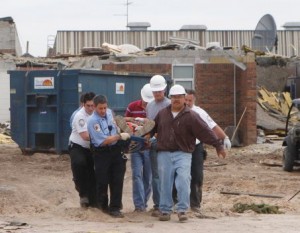 In 2010, there were an estimated 139,064,000 civilian workers in the U.S. private and public sector employed labor force, according to the Bureau of Labor Statistics Current Population Survey . Each day, many of these workers suffer injury, disability, and death from workplace incidents. In 2010, more than 4,500 U.S. workers died from occupational injuries. Although difficult to enumerate, annually about 49,000 deaths are attributed to work-related illnesses. In 2010, an estimated 3.9 million workers in private industry and state and local government had a nonfatal occupational injury or illness. Of those workers, 2 million were transferred, placed on work restrictions, or took time away from work. In the same year an estimated 2.6 million workers were treated in emergency departments for occupational injuries and illnesses, and approximately 110,000 of these workers were hospitalized (NIOSH, unpublished data, 2012).
In 2010, there were an estimated 139,064,000 civilian workers in the U.S. private and public sector employed labor force, according to the Bureau of Labor Statistics Current Population Survey . Each day, many of these workers suffer injury, disability, and death from workplace incidents. In 2010, more than 4,500 U.S. workers died from occupational injuries. Although difficult to enumerate, annually about 49,000 deaths are attributed to work-related illnesses. In 2010, an estimated 3.9 million workers in private industry and state and local government had a nonfatal occupational injury or illness. Of those workers, 2 million were transferred, placed on work restrictions, or took time away from work. In the same year an estimated 2.6 million workers were treated in emergency departments for occupational injuries and illnesses, and approximately 110,000 of these workers were hospitalized (NIOSH, unpublished data, 2012).
Each year occupational injuries and illnesses cause employers, workers, and society to pay tremendous costs for workers’ compensation and other insurance, medical expenses, lost wages and productivity, and the personal and societal costs associated with day to day living for injured and ill workers. In 2009, employers spent $74 billion on workers’ compensation insurance alone.
via CDC – Directory of NIOSH Traumatic Occupational Injury Resources.
Respirators
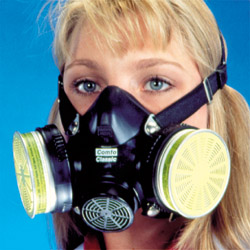 Respirators protect the user in two basic ways. The first is by the removal of contaminants from the air. Respirators of this type include particulate respirators, which filter out airborne particles; and “gas masks” which filter out chemicals and gases. Other respirators protect by supplying clean respirable air from another source. Respirators that fall into this category include airline respirators, which use compressed air from a remote source; and self-contained breathing apparatus (SCBA), which include their own air supply.
Respirators protect the user in two basic ways. The first is by the removal of contaminants from the air. Respirators of this type include particulate respirators, which filter out airborne particles; and “gas masks” which filter out chemicals and gases. Other respirators protect by supplying clean respirable air from another source. Respirators that fall into this category include airline respirators, which use compressed air from a remote source; and self-contained breathing apparatus (SCBA), which include their own air supply.
via CDC – Respirators – NIOSH Workplace Safety and Health Topic.
Portable Ladder Safety
 Falls from portable ladders (step, straight, combination and extension) are one of the leading causes of occupational fatalities and injuries.
Falls from portable ladders (step, straight, combination and extension) are one of the leading causes of occupational fatalities and injuries.
- Read and follow all labels/markings on the ladder.
- Avoid electrical hazards! – Look for overhead power lines before handling a ladder. Avoid using a metal ladder near power lines or exposed energized electrical equipment.
- Always inspect the ladder prior to using it. If the ladder is damaged, it must be removed from service and tagged until repaired or discarded.
- Always maintain a 3-point (two hands and a foot, or two feet and a hand) contact on the ladder when climbing. Keep your body near the middle of the step and always face the ladder while climbing (see diagram).
- Only use ladders and appropriate accessories (ladder levelers, jacks or hooks) for their designed purposes.
- Ladders must be free of any slippery material on the rungs, steps or feet.
- Do not use a self-supporting ladder (e.g., step ladder) as a single ladder or in a partially closed position.
- Do not use the top step/rung of a ladder as a step/rung unless it was designed for that purpose.
- Use a ladder only on a stable and level surface, unless it has been secured (top or bottom) to prevent displacement.
- Do not place a ladder on boxes, barrels or other unstable bases to obtain additional height.
- Do not move or shift a ladder while a person or equipment is on the ladder.
- An extension or straight ladder used to access an elevated surface must extend at least 3 feet above the point of support (see diagram). Do not stand on the three top rungs of a straight, single or extension ladder.
- The proper angle for setting up a ladder is to place its base a quarter of the working length of the ladder from the wall or other vertical surface (see diagram).
- A ladder placed in any location where it can be displaced by other work activities must be secured to prevent displacement or a barricade must be erected to keep traffic away from the ladder.
- Be sure that all locks on an extension ladder are properly engaged.
- Do not exceed the maximum load rating of a ladder. Be aware of the ladder’s load rating and of the weight it is supporting, including the weight of any tools or equipment.
